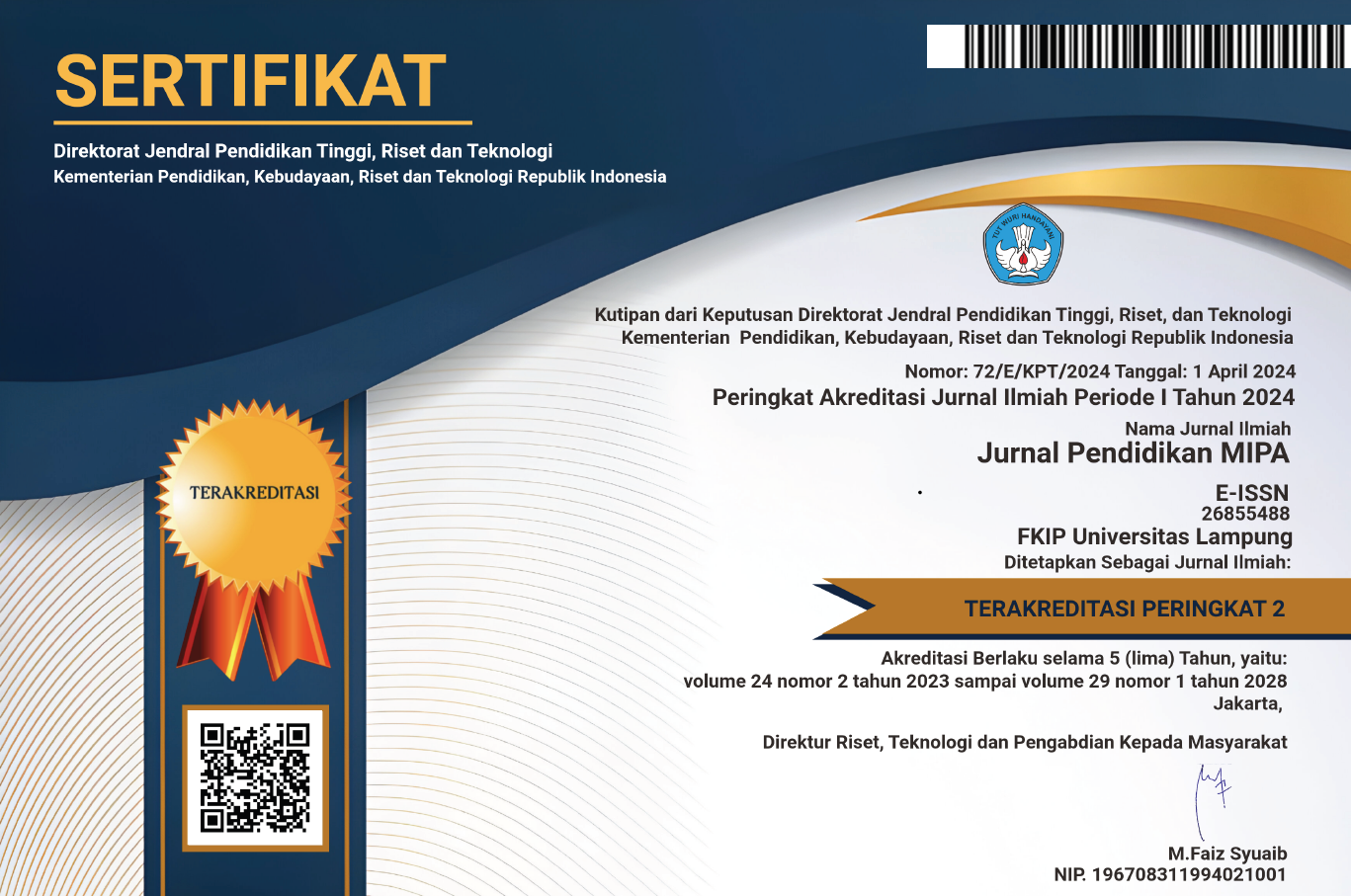Evaluating the Numeracy Cognitive Level of Indonesian Elementary School Students using the Minimum Competency Assessment
 Country:
Country:
(1) University of Lampung, Indonesia
(2) University of Lampung, Indonesia
(3) University of Lampung, Indonesia
(4) UIN Raden Intan Lampung, Indonesia
(5) STMIK Tunas Bangsa, Indonesia
(6) IAIN Syekh Nurjati, Indonesia
This study aims to describe the achievement of the numeracy cognitive level of elementary school students on a minimum competency assessment. The population of this study were fifth grade students at C-accredited elementary school in Lampung province. The sample of this study selected using stratified random sampling. Data were collected using a level 2 numeracy test instrument developed by the Center for Evaluation and Learning of the Ministry of Education and Culture of the Republic of Indonesia. Data were analyzed descriptively and inferentially using the Mann-Whitney test. It was concluded that: a) students’ category of numeracy ability was “competent” (mean score 43.04); b) there is no significant difference between the numeracy abilities of male and female students; c) the highest percentage of correct answers was matching type questions (62.9%); and d) the lowest cognitive level was achieved is in the measurement concept which was only 28.6.
Keywords: elementary school students, minimum competency assessment, numeracy cognitive level.
Abduh, M. (2019). Rintisan Pelatihan Dasar Pembelajaran Literasi dan Kepemimpinan untuk Pembelajaran di NTT [Pioneer of Basic Literacy and Leadership Learning Training for Learning in NTT]. Asesmen, 16(1), 3–14.
Alberta. (2018). Literacy and Numeracy Progressions. Retrieved from https://education.alberta.ca/literacy-and-numeracy/.
Ekowati, D. W., Astuti, Y. P., Utami, I. W. P., Mukhlishina, I., & Suwandayani, B. I. (2019). Literasi Numerasi di SD Muhammadiyah [Mathematical Literacy in Muhammadiyah Elementary School]. ELSE (Elementary School Education Journal): Jurnal Pendidikan Dan Pembelajaran Sekolah Dasar, 3(1), 93–101.
Furnham, A., Batey, M., & Martin, N. (2011). How would you like to be evaluated? The correlates of students’ preferences for assessment methods. Personality and Individual Differences, 50(2), 259–263.
Goodman, M., et al. (2013). Literacy, Numeracy, and Problem Solving in Technology-Rich Environments Among U.S. Adults: Results from the Program for the International Assessment of Adult Competencies 2012 First Look. NCES: U.S. Department of Education.
Holmes, W., & Dowker, A. (2013). Catch Up Numeracy: A targeted intervention for children who are low-attaining in mathematics. Research in Mathematics Education, 15(3), 249–265.
Indriani, T., Suyatna, A., & Ertikanto, C. (2015). Pengembangan Kuis Interaktif Tipe True/False untuk Melatih Kemampuan Eksplorasi Fenomena Fisika [The Development of True/False Type Interactive Quiz to Mastery Physical Phenomenon Exploration Skills]. Jurnal Pembelajaran Fisika, 3(1), 131–140.
Jordan, N. C., et al. (2009). Early numeracy matters: Kindergarten number competence and later mathematics outcomes. Developmental Psychology, 45(3), 850–867.
Kementerian Pendidikan dan Kebudayaan. (2017). Gerakan literasi nasional. Retrieved from http://gln.kemdikbud.go.id.
Kemendikbud. (2022). Buku Saku Merdeka Belajar ke-19: Rapor Pendidikan Indonesia untuk Satuan Pendidikan. Retrieved from https://pusmejar.kemendikbud.go.id
Mahmud, M. R., & Pratiwi, I. M. (2019). Literasi Numerasi Siswa dalam Pemecahan Masalah Tidak Terstruktur [Student Numerical Literacy in Unstructured Problem Solving]. KALAMATIKA Jurnal Pendidikan Matematika, 4(1), 69–88.
Nelson, G., & McMaster, K. L. (2019). The effects of early numeracy interventions for students in preschool and early elementary: A meta-analysis. Journal of Educational Psychology, 111(6), 1001–1022.
Perdana, R., & Suswandari, M. (2021). Literasi Numerasi dalam Pembelajaran Tematik Siswa Kelas Atas Sekolah Dasar [Numerical Literacy in Thematic Learning of Elementary School Students]. Absis: Mathematics Education Journal, 3(1), 9–15.
Purpura, D. J., Hume, L. E., Sims, D. M., & Lonigan, C. J. (2011). Early literacy and early numeracy: The value of including early literacy skills in the prediction of numeracy development. Journal of Experimental Child Psychology, 110, 647–658.
Pusmenjar. (2020). Modul Asesmen Awal Matematika SD/MI Kelas 4. Badan Penelitian dan Pengembangan dan Perbukuan: Kementerian Pendidikan dan Kebudayaan.
Traub, E. R. (1990). Multiple-Choice vs. free-response in the testing of scholastic achievement. Ontario Institute for Studies in Education.
Turhan, N. S. (2020). Why Do Students Prefer Different Question Types? Retrieved from https://files.eric.ed.gov/fulltext/EJ1256344.pdf
Yustitia, V., Siswono, T. Y. E., & Abadi. (2021). Numeracy of prospective elementary school teachers: a case study. J. Phys.: Conf. Ser. 1918 042077, 1–4.
Refbacks
- There are currently no refbacks.

This work is licensed under a Creative Commons Attribution-ShareAlike 4.0 International License.






